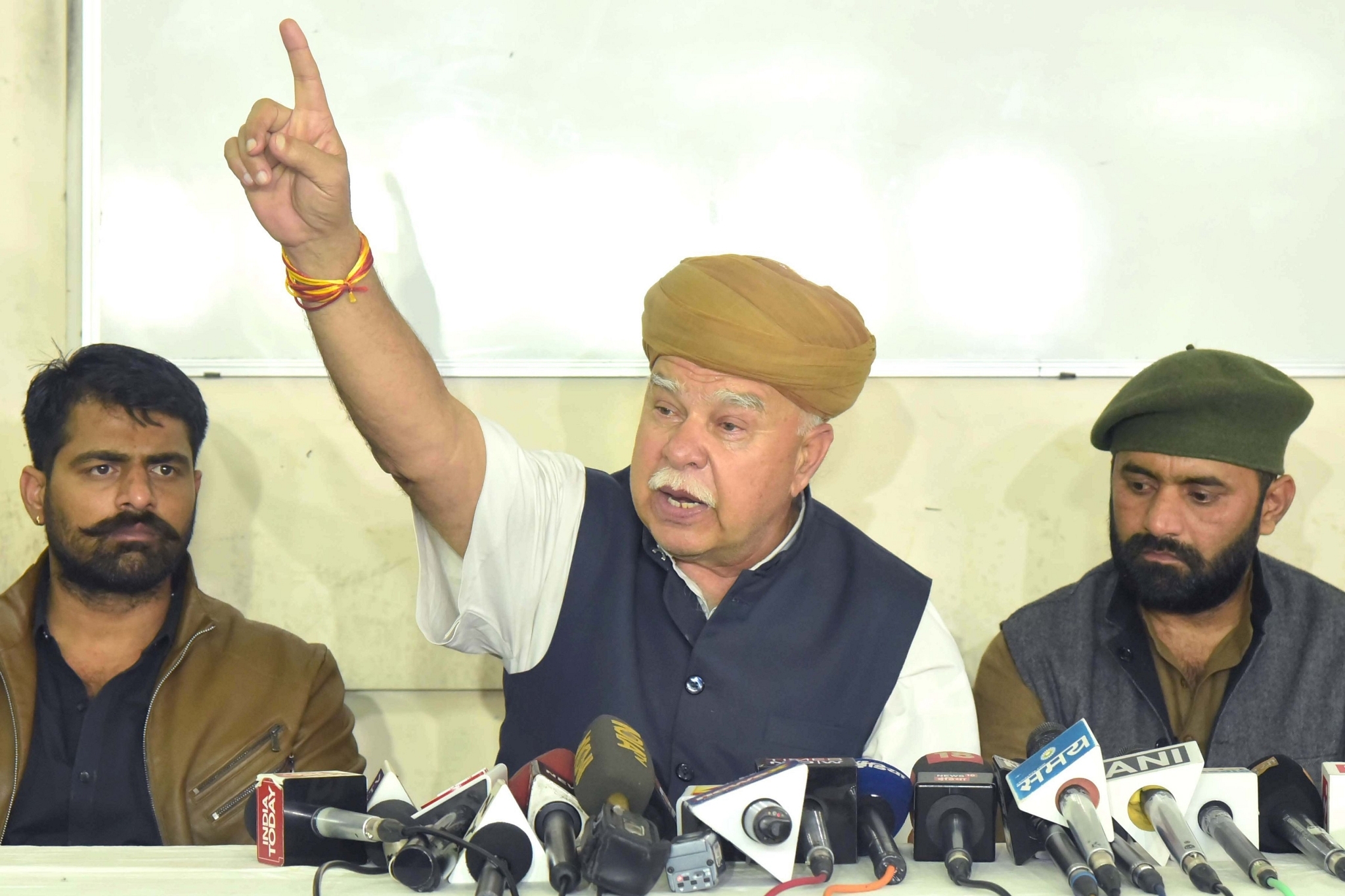Politics
Rajasthan Votes: How Much Of A Factor Is The Rajput Karni Sena?
- Almost a year after Padmaavat, how much of a force is the Rajput Karni Sena on the ground in Rajasthan?

Shri Rajput Karni Sena Chief Lokendra Singh Kalvi (Prabhakar Sharma/Hindustan Times via GettyImages)
Earlier this year, Rajasthan was in turmoil because of a movie. What was previously heard in hushed whispers, soon became a full-fledged calamity, with accusations that the movie Padmaavat had hurt Rajput pride. From street protests to threats to lead actors, Rajput men and women voiced their anger and resentment in unambiguous terms in many places across north and western India.
The Rajputs constitute about 10-12 per cent of the population in the state and have a strong role to play in at least 30 of the 200 assembly constituencies particularly in the Marwar region. They also have traditionally been voters of the Bharatiya Janata Party (BJP), while the Jats are considered to be Congress voters. Therefore, the sway of Rajput voters in every election is critical for the fortunes of the two major parties. In the light of the happenings in the state in the past two years, the Rajput factor gains even more prominence.
In what became one of the most defining moments of politics in 2018, the Karni Sena, a lesser-known caste-based group of Rajasthan found itself at the centre of the storm. A few months down the line as Rajasthan goes to polls, it is important to see whether the Padmaavat protests, the Karni Sena and the Rajput resentment in general is having any impact in the state.
One of our regular contributors, Kamalpreet Singh Gill wrote a detailed piece on the evolution of Karni Sena in the state. The Karni Sena was founded in the year 2006, when its current leader Lokendra Singh Kalvi, quit the BJP. Gill writes that the motive behind the formation of the Karni Sena was to, “...mobilise Rajputs against a system that had, in his view, become heavily antagonistic to them through decades-long process of social engineering”.
In January, Kalvi seemed to be the man of the moment, using the Padmaavat agitation as a step-hold to accumulate more political gains. In February, Kalvi celebrated the victory of Congress in the bypoll elections in Ajmer, Alwar and Mandalgarh and said that the BJP was trounced for not being proactive in banning the movie Padmaavat in the state. Closer to the election, Kalvi famously announced that he and 50 lakh Karni Sainiks have resolved to defeat the BJP in the upcoming elections. He vociferously speaks against the BJP in Swabhiman Sammelans (self-respect meetings) held across the state and the issues range from the lack of support of the BJP during the Padmaavat agitation to reservation demands for Rajputs.
Just two weeks back, Karni Sena took the fight to Jhalrapatan, the constituency of Chief Minister Vasundhara Raje. Kalvi standing in support of Manavendra Singh (who has quit the BJP and joined the Congress) said that the fight in Jhalrapatan is essentially between a real Rajput and a non-Rajput.
Swarajya spoke to political commentator and analyst Pradip Bhandari from Jan Ki Baat to get a sense of how the Karni Sena factor in weighing on the voting decisions of the Rajput community. Bhandari was of the opinion that the immense power of the Sena in the area is the product of a media hype and their impact on the field is limited. He went on to say that while the Karni Sena could bring in some amount of social mobilisation, it is not expected to change into tangible voting patterns for the larger Rajput community.
Bhandari said that, whatever resentment or disappointment that the Rajput community could have about the BJP, is only visible at the level of constituencies and there is no larger template to it. One of the key issues mobilising the Rajputs in the state, is the murder of Anand Pal Singh, a Ravana Rajput from Nagaur. The death of Singh, a noted gangster in the area, managed to bring the Rajput community out on the streets with a demand for a CBI enquiry into what they believed was a staged encounter. In some constituencies in the Marwar region and particularly in Nagaur and Barmer, the Anandpal Singh factor could still play an influencing role in the election of local BJP candidates. A number of Rajput protestors were arrested during the agitation over the death of Anandpal Singh and that remains a contentious issue, particularly among the youth.
Another issue that has raised its head during this election is the demand for reservations among Rajputs. The Rajput Sangharsh Samiti led by Giriraj Singh Lotwara has held multiple meetings in major cities of Rajasthan to press on the demand.
As Rajasthan goes to polls tomorrow, it will be interesting to see how the Rajput factor plays out and the clues it leaves behind for the big battle of 2019.
Support Swarajya's 50 Ground Reports Project & Sponsor A Story
Every general election Swarajya does a 50 ground reports project.
Aimed only at serious readers and those who appreciate the nuances of political undercurrents, the project provides a sense of India's electoral landscape. As you know, these reports are produced after considerable investment of travel, time and effort on the ground.
This time too we've kicked off the project in style and have covered over 30 constituencies already. If you're someone who appreciates such work and have enjoyed our coverage please consider sponsoring a ground report for just Rs 2999 to Rs 19,999 - it goes a long way in helping us produce more quality reportage.
You can also back this project by becoming a subscriber for as little as Rs 999 - so do click on this links and choose a plan that suits you and back us.
Click below to contribute.
Latest